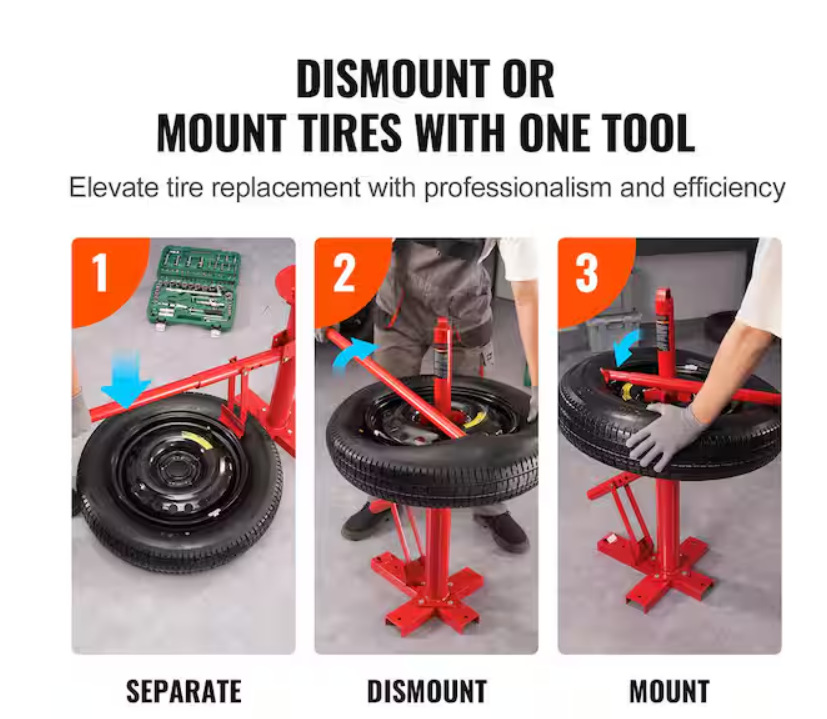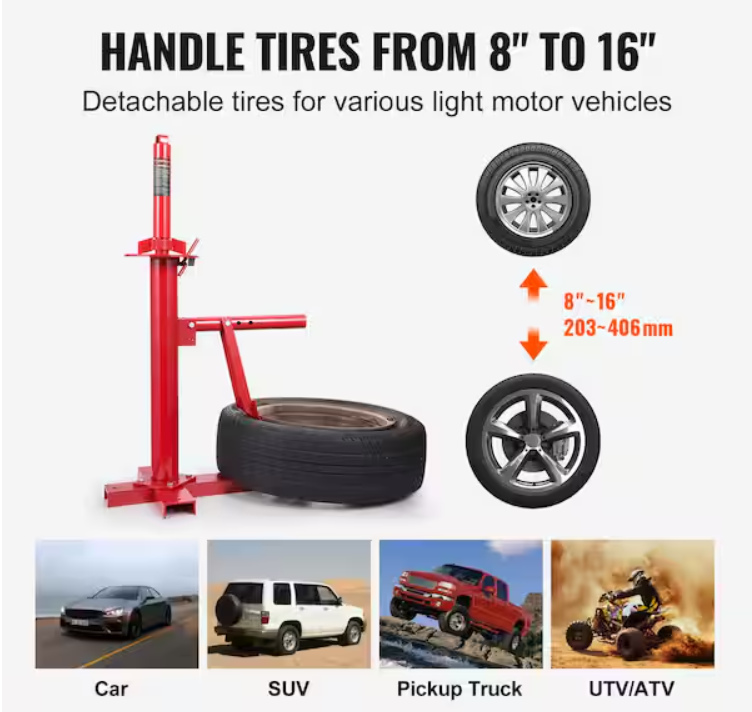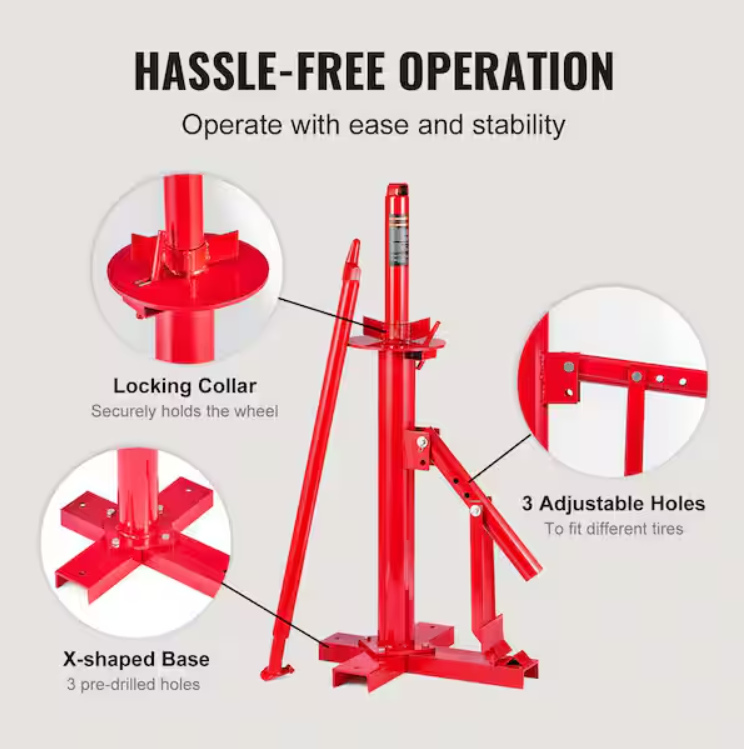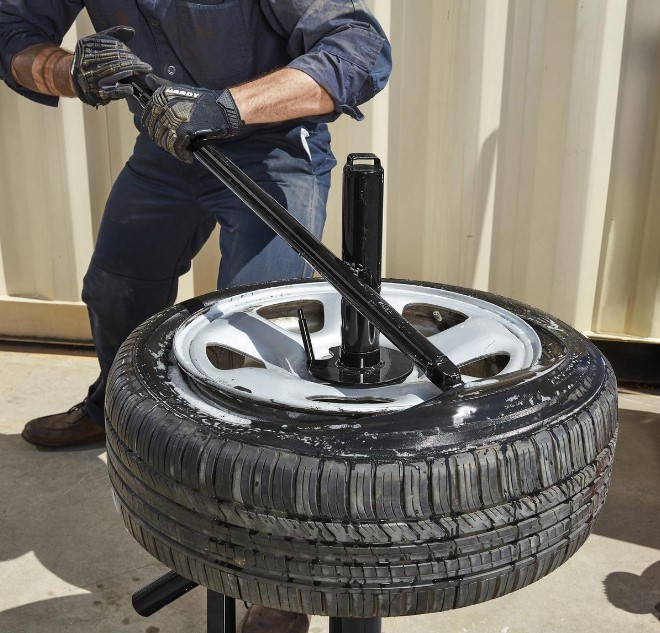Manual tire changers, also known as tire mounting machines, are essential tools for automotive repair shops, garages, and DIY enthusiasts. These devices allow users to safely and efficiently remove and install tires on vehicle rims without causing damage to either component.
The origins of manual tire changers can be traced back to the early 20th century when the automotive industry was in its infancy. As cars became more prevalent, the need for specialized equipment to service and maintain tires arose. Initially, tire changes were performed entirely by hand, a laborious and time-consuming process. The invention of manual tire changers revolutionized this task, making it more efficient and accessible to a wider range of users.
One of the primary advantages of manual tire changers over their automatic counterparts is their simplicity and affordability. Manual models typically consist of fewer moving parts and require less complex mechanisms, making them more cost-effective and easier to maintain. Additionally, their manual operation allows users to have greater control over the tire changing process, which can be beneficial when working with specialized or unique tire and rim combinations.
Another advantage of manual tire changers is their versatility. Many models can accommodate a wide range of tire and rim sizes, making them suitable for use in various automotive applications, from passenger vehicles to light trucks and even some heavy-duty equipment. This versatility makes manual tire changers an attractive option for smaller repair shops or DIY enthusiasts who may need to service a diverse range of vehicles.
Table of Contents

Types of Manual Tire Changers
Manual tire changers come in various designs, each with its own unique mechanism for removing and mounting tires. The three main types are leverage-type, scissor-type, and turntable-type.
Leverage-type Tire Changers
Leverage-type tire changers are among the most common and affordable options. They feature a long lever arm that provides the necessary mechanical advantage to pry the tire bead off the rim. These units typically include a mounting head with specialized tools to aid in the tire changing process. Leverage-type changers are suitable for most passenger car and light truck tires.
Scissor-type Tire Changers
Scissor-type tire changers, also known as side-mount or swing-arm changers, utilize a scissor-like mechanism to mount and demount tires. They offer a more controlled and precise tire changing experience, making them a popular choice for handling larger tires or specialty wheels. Scissor-type changers often have additional features like bead breakers and wheel clamps for added convenience.
Turntable-type Tire Changers
Turntable-type tire changers are designed for high-volume tire shops and professional use. They incorporate a rotating turntable or wheel clamp that holds the wheel in place while the mounting head moves around the rim. This design allows for efficient and consistent tire changes, particularly for larger tires or those with stiff sidewalls. Turntable-type changers are typically more expensive but offer increased productivity and ergonomic benefits.
Essential Components
A manual tire changer consists of several essential components that work together to facilitate the process of removing and installing tires on wheels. These components include:
Mounting Head: The mounting head is a critical component that assists in mounting and demounting tires. It typically features a clamp or hook that grips the tire bead, allowing you to pull the tire over the rim during installation or removal. The mounting head is adjustable to accommodate different wheel sizes.
Bead Breaker: The bead breaker is a tool used to break the seal between the tire bead and the wheel rim. It consists of a blade or lever that applies force to the tire, separating the bead from the rim. This component is essential for removing tires, especially those that are tightly seated.
Turntable: The turntable is a rotating platform that holds the wheel in place during the tire changing process. It allows you to spin the wheel, making it easier to work on different sections of the tire. Some turntables are powered, while others require manual rotation.
Clamps: Clamps are used to secure the wheel to the turntable, ensuring it remains stable and in position during the tire changing process. They typically feature adjustable jaws or clamps that grip the wheel rim firmly.
Bead Lubricant: While not a physical component, bead lubricant is an essential accessory for manual tire changers. It helps lubricate the tire bead and rim, making it easier to mount and demount tires, reducing the risk of damage to the tire or wheel.
Tire Levers: Tire levers are handy tools used to pry the tire bead over the rim during the mounting and demounting process. They are typically made of durable materials like plastic or metal and are designed to minimize damage to the tire and wheel.
These essential components work together to provide a complete manual tire changing solution, enabling you to safely and effectively remove and install tires on various wheel sizes and types.

Safety Precautions
Working with manual tire changers involves handling heavy equipment and components, making safety an utmost priority. Proper precautions should be taken to prevent injuries and ensure a smooth tire changing process.
Proper Tire Inflation: Before attempting to remove or install a tire, always check and adjust the tire’s air pressure to the recommended level. Over-inflated or under-inflated tires can be hazardous and increase the risk of accidents.
Securing the Tire: Ensure the tire is securely mounted on the tire changer before beginning the process. Failure to properly secure the tire can result in it slipping or falling off, potentially causing serious harm.
Handling Heavy Equipment: Manual tire changers often involve lifting and maneuvering heavy components, such as the tire itself, mounting head, and bead breaker. Use proper lifting techniques, and seek assistance if needed to avoid strain or injury.
Protective Gear: Wear appropriate personal protective equipment (PPE) when operating a manual tire changer. This includes safety glasses or goggles to protect your eyes from debris, sturdy gloves to improve grip and prevent cuts, and steel-toed boots to protect your feet.
Work Area: Keep your work area clean and organized to prevent tripping hazards and ensure a clear path for moving tires and equipment. Adequate lighting is also crucial for safe operation.
Maintenance: Regularly inspect and maintain your manual tire changer to ensure all components are in good working condition. Damaged or worn parts should be replaced immediately to prevent potential failures or accidents.
Training and Supervision: If you are new to using a manual tire changer, seek proper training and supervision from experienced professionals. Understand the equipment’s operation and safety protocols before attempting to use it independently.
By following these safety precautions, you can minimize the risks associated with manual tire changing and ensure a safe and efficient process.
Step-by-Step Tire Changing Process
Changing a tire using a manual tire changer involves a series of precise steps to ensure the job is done safely and effectively. Here’s a detailed guide on the process:
- Preparation
- Park the vehicle on a level surface and engage the parking brake.
- Loosen the lug nuts on the flat tire, but don’t remove them yet.
- Position the manual tire changer next to the flat tire.
- Lifting the Vehicle
- If necessary, use a jack to lift the vehicle and create enough clearance to remove the flat tire.
- Follow the manufacturer’s instructions for proper jack placement and operation.
- Removing the Flat Tire
- Fully remove the lug nuts and set them aside in a safe place.
- Pull the flat tire off the vehicle and place it on the ground.
- Mounting the New Tire
- Inspect the new tire for any damage or defects before mounting.
- Place the new tire on the manual tire changer’s mounting head.
- Use the tire changer’s tools to guide the upper bead of the tire over the mounting head.
- Repeat the process for the lower bead, ensuring the tire is properly seated on the rim.
- Inflating the Tire
- Connect an air compressor or inflation device to the valve stem.
- Partially inflate the tire to create a slight bulge, making it easier to install on the vehicle.
- Installing the New Tire
- Lift the partially inflated tire onto the vehicle’s wheel hub.
- Hand-tighten the lug nuts in a crisscross pattern.
- Lowering the Vehicle
- If you used a jack, carefully lower the vehicle back to the ground.
- Tightening the Lug Nuts
- Use a torque wrench to tighten the lug nuts in the proper sequence and to the recommended torque specifications.
- Final Checks
- Double-check that the tire is properly seated and inflated to the correct pressure.
- Replace the hubcap or wheel cover, if applicable.
- Cleanup and Storage
- Properly store the manual tire changer and any tools used in a clean, dry location.
- Dispose of the old tire according to local regulations.
Remember, changing a tire using a manual tire changer requires physical effort and proper technique. If you’re unsure or uncomfortable with the process, it’s always best to seek professional assistance.

Maintenance and Care
Proper maintenance and care are crucial for ensuring the longevity and safe operation of a manual tire changer. Regular cleaning, lubrication, and inspections can help prevent breakdowns, extend the lifespan of the equipment, and minimize potential safety hazards.
Cleaning
Keeping your manual tire changer clean is essential for smooth operation and preventing corrosion or damage. After each use, wipe down all surfaces with a clean, dry cloth to remove any dirt, debris, or residual lubricant. Pay special attention to the bead breaker, mounting head, and other moving parts, ensuring they are free of any obstructions or buildup.
For a more thorough cleaning, you can use a mild degreaser or solvent-based cleaner specifically designed for automotive tools and equipment. Avoid using harsh chemicals or abrasive materials that could damage the finish or components of your tire changer.
Lubrication
Regular lubrication is crucial for maintaining the smooth operation of your manual tire changer. Consult your owner’s manual for the recommended lubricants and application points. Typically, you’ll need to lubricate the mounting head, bead breaker, and any other moving parts with a high-quality, multi-purpose grease or lubricant designed for automotive tools.
Before applying lubricant, ensure that all surfaces are clean and free of dirt or debris. Apply a thin, even layer of lubricant to the designated areas, being careful not to over-lubricate, as excess lubricant can attract dirt and debris, leading to premature wear or malfunctioning.
Storage
Proper storage is essential for protecting your manual tire changer from environmental factors that could cause damage or corrosion. When not in use, store your tire changer in a dry, well-ventilated area, away from direct sunlight, moisture, and extreme temperatures.
If possible, cover the tire changer with a protective cover or tarp to prevent dust accumulation and protect it from accidental impacts or scratches. Additionally, consider storing the tire changer on a sturdy, level surface to prevent any potential damage or instability.
Regular Inspections
Conducting regular inspections is crucial for identifying potential issues or wear before they become major problems. Inspect all components of your manual tire changer, including the mounting head, bead breaker, clamps, and any moving parts, for signs of wear, damage, or excessive play.
Pay close attention to any cracks, dents, or deformities in the metal components, as these could indicate structural weaknesses or potential failure points. Additionally, check for any loose bolts, nuts, or fasteners and tighten them as needed.
If you notice any significant wear or damage, it’s essential to replace the affected components promptly to ensure safe and reliable operation.
By following these maintenance and care guidelines, you can extend the lifespan of your manual tire changer, ensure optimal performance, and minimize potential safety risks associated with faulty or poorly maintained equipment.
Choosing the Right Manual Tire Changer
Selecting the appropriate manual tire changer is crucial for ensuring safe and efficient tire changes. Several factors should be considered when making this decision:
Tire Size and Weight Capacity: Manual tire changers are designed to handle specific tire sizes and weight ranges. It’s essential to choose a model that can accommodate the types of tires you’ll be working with, whether they’re standard passenger vehicle tires, light truck tires, or even larger commercial vehicle tires. Check the manufacturer’s specifications to ensure the tire changer can handle the maximum tire diameter, width, and weight you anticipate working with.
Workspace Considerations: Evaluate the available space in your garage or workshop. Manual tire changers require a certain amount of clearance around them for maneuvering tires and operating the equipment safely. Consider the overall footprint of the tire changer, as well as the necessary space for positioning vehicles and storing tools and accessories.
Budget: Manual tire changers are available at various price points, ranging from entry-level models to professional-grade equipment. Determine your budget and prioritize the features that are most important to you. While more expensive models may offer additional capabilities and durability, entry-level options can still provide reliable performance for basic tire changes.
Ease of Use: Consider the ergonomics and user-friendliness of the manual tire changer. Look for models with well-designed handles, levers, and controls that allow for comfortable and efficient operation. Additionally, some models may offer features like adjustable mounting heads or assist arms to simplify the tire changing process.
Durability and Longevity: Manual tire changers are subjected to significant stress and wear during use. Invest in a model constructed from high-quality materials, such as sturdy steel frames and reinforced components. Reputable brands often offer longer warranties and better customer support, ensuring your investment lasts for years to come.
Portability: If you anticipate the need to move your manual tire changer frequently or transport it to different job sites, consider models with built-in wheels or casters for easy mobility. Portable tire changers can be especially useful for mobile mechanics or those with limited workspace.
By carefully evaluating these factors, you can select a manual tire changer that meets your specific needs, ensures safe and efficient operation, and provides long-lasting performance.
Common Issues and Troubleshooting
One of the most common issues faced when using a manual tire changer is the difficulty in breaking the bead of the tire from the rim. This can be a frustrating and physically demanding task, especially for larger tires or those that have been on the vehicle for an extended period. To address this issue, it’s essential to use the proper techniques and tools.
Firstly, ensure that the tire is adequately lubricated with a tire lubricant or soap solution. This will help reduce friction and make it easier to break the bead. Next, use the tire changer’s bead breaker tool to apply pressure to the tire’s sidewall, working your way around the circumference of the tire. It’s crucial to apply sufficient force and leverage to break the bead without damaging the tire or the rim.
Another common problem is the difficulty in mounting the tire onto the rim. This can be caused by a variety of factors, including improper lubrication, damaged or worn rims, or incorrect tire sizing. To overcome this issue, ensure that the rim and tire are compatible and in good condition. Apply a generous amount of tire lubricant to both the tire and the rim, and use the tire changer’s mounting tools to guide the tire onto the rim. It may be necessary to use additional tools, such as a tire iron or a bead buddy, to help seat the tire properly.
Lastly, leaks can be a frustrating issue when changing tires manually. These leaks can occur due to damaged valve stems, improper bead seating, or punctures in the tire. To address leaks, inspect the tire and rim thoroughly for any signs of damage or debris. Replace the valve stem if necessary, and ensure that the tire is properly seated on the rim. If a puncture is found, it may be possible to repair it using a tire plug or patch kit.
Regular maintenance and proper use of the manual tire changer can help prevent many of these common issues. Always refer to the manufacturer’s instructions and safety guidelines, and don’t hesitate to seek professional assistance if you encounter persistent or complex problems.
Accessories and Additional Tools
While a manual tire changer is the primary tool for changing tires, there are several accessories and additional tools that can make the process easier, safer, and more efficient. Here are some essential accessories and tools to consider:
Bead-bagging Tools: These tools are designed to help break the bead of the tire from the rim. They come in various shapes and sizes, including duck-head tools, spoons, and lever tools. Using the right bead-bagging tool can significantly reduce the effort required to break the bead and prevent damage to the tire or rim.
Tire Lubricants: Applying a tire lubricant to the bead area of the tire and rim can make it easier to mount and demount tires. Tire lubricants help reduce friction and prevent the tire from sticking to the rim, which can cause damage or make the process more difficult. Look for lubricants specifically designed for tire changing, as they are formulated to be long-lasting and effective.
Rim Protectors: These are rubber or plastic guards that fit over the rim to protect it from scratches and dents during the tire changing process. Rim protectors are especially useful when working with alloy or custom rims, as they can prevent costly damage.
Tire Mounting Paste: This paste is applied to the rim and tire bead area to help the tire seat properly on the rim. Tire mounting paste can also help prevent the tire from slipping or spinning on the rim during the mounting process.
Valve Core Tool: A valve core tool is used to remove and install valve cores in tire valve stems. This tool is essential for inflating tires and checking or adjusting tire pressure.
Tire Pressure Gauge: A reliable tire pressure gauge is a must-have accessory for ensuring that tires are inflated to the correct pressure after mounting. Proper tire pressure is crucial for safety, fuel efficiency, and tire life.
Wheel Weights: If you’re also balancing tires after mounting them, you’ll need a supply of wheel weights. These weights are applied to the rim to counterbalance any imbalances in the tire and wheel assembly.
By having the right accessories and additional tools on hand, you can make the tire changing process more efficient, safer, and easier to complete successfully.
Manual vs. Automatic Tire Changers
Manual tire changers offer a cost-effective solution for individuals and small automotive shops. While they require more physical effort, they provide greater control and precision during the tire changing process. Manual changers are well-suited for low-volume operations or situations where space is limited. They are also more portable and easier to maintain compared to their automatic counterparts.
Pros of Manual Tire Changers:
- Affordable initial investment
- Compact and space-saving design
- Increased control and precision
- Suitable for low-volume operations
- Portable and easy to move around
Cons of Manual Tire Changers:
- Requires significant physical effort
- Slower tire changing process
- Limited capacity for larger or specialized tires
- Increased risk of tire or rim damage due to human error
On the other hand, automatic tire changers are designed for high-volume operations and offer a faster, more efficient tire changing process. These machines are typically more expensive but can handle a wider range of tire sizes and types. Automatic changers reduce the physical strain on technicians and minimize the risk of tire or rim damage.
Pros of Automatic Tire Changers:
- Faster and more efficient tire changing process
- Capable of handling a wide range of tire sizes and types
- Reduced physical strain on technicians
- Lower risk of tire or rim damage
- Suitable for high-volume operations
Cons of Automatic Tire Changers:
- Higher initial investment cost
- Larger footprint and space requirements
- Increased maintenance and repair costs
- Potential for operator error leading to damage
Ultimately, the choice between manual and automatic tire changers depends on factors such as the volume of work, available space, budget, and specific needs of the automotive service operation. Manual changers are well-suited for individuals, hobbyists, or small shops with limited resources, while automatic changers are ideal for larger facilities or high-volume operations that prioritize efficiency and productivity.
Professional Tips and Tricks
Changing tires manually can be a challenging task, especially for those who are new to the process. However, with the right techniques and best practices, you can make the job easier and more efficient. Here are some professional tips and tricks from experienced tire technicians:
Lubrication is Key: Always apply a generous amount of tire lubricant or soap solution to the tire beads and rim before attempting to mount or dismount a tire. This will help reduce friction and prevent damage to the tire and rim.
Use the Right Tools: Invest in high-quality tire changing tools, such as spoons, levers, and bead breakers. Cheap or poorly designed tools can make the job more difficult and increase the risk of damage.
Proper Positioning: Position the tire changer at a comfortable height and ensure that you have enough space to work around it. This will help prevent back strain and improve your control over the process.
Start with the Easier Side: When mounting a tire, start with the easier side first. This is typically the side with the smaller bead, as it’s easier to position and seat properly.
Use the Bead Breaker Effectively: When breaking the bead, apply firm and consistent pressure with the bead breaker. Avoid using excessive force, as this can damage the tire or rim.
Inspect the Tire and Rim: Before mounting a tire, inspect both the tire and rim for any signs of damage or irregularities. This can help prevent potential issues and ensure a proper fit.
Utilize Tire Lubricant Sparingly: While lubricant is essential, using too much can cause the tire to slip off the rim during inflation. Apply just enough to facilitate the mounting and dismounting process.
Inflate Gradually: When inflating a mounted tire, do so gradually and in increments. This will allow the tire to seat properly and prevent any sudden pressure buildup that could cause damage or injury.
Practice Makes Perfect: The more experience you have with manual tire changing, the more efficient and confident you’ll become. Take the time to practice and refine your techniques for optimal results.
Remember, safety should always be the top priority when working with manual tire changers. Follow the manufacturer’s instructions, wear appropriate protective equipment, and don’t hesitate to seek guidance from experienced professionals when needed.
Future of Manual Tire Changers
While manual tire changers have been a staple in the automotive industry for decades, the future holds exciting developments and innovations. As technology continues to advance, we can expect to see new features and improvements that enhance efficiency, safety, and user experience.
One emerging trend is the integration of digital interfaces and connectivity features. Manual tire changers may soon incorporate touchscreen displays, wireless connectivity, and even augmented reality (AR) capabilities. These advancements could provide real-time guidance, instructional videos, and diagnostics, making the tire changing process more streamlined and user-friendly.
Additionally, the use of lightweight yet durable materials, such as carbon fiber and advanced composites, could lead to more portable and ergonomic manual tire changers. These materials could reduce the overall weight and improve maneuverability, making it easier for technicians to transport and operate the equipment.
Advancements in sensor technology and machine learning algorithms may also play a role in the future of manual tire changers. Sensors could potentially detect tire conditions, tread depth, and pressure levels, providing valuable data for maintenance and repair decisions. Machine learning algorithms could analyze this data and offer predictive maintenance recommendations, helping to extend the lifespan of tires and equipment.
Furthermore, the integration of safety features, such as automatic locking mechanisms and fail-safe systems, could become more prevalent. These features would help prevent accidents and ensure a safer working environment for technicians.
As sustainability becomes an increasingly important consideration, we may also see the development of more eco-friendly manual tire changers. This could involve the use of recycled materials, energy-efficient designs, and the incorporation of renewable energy sources, such as solar panels or kinetic energy harvesting systems.
Overall, the future of manual tire changers is poised for exciting advancements that will enhance efficiency, safety, and user experience, while also promoting sustainability and embracing the latest technological innovations.
Resources and Further Reading
Recommended Books:
- “The Complete Guide to Tire Changing” by John Smith – A comprehensive manual covering all aspects of tire changing, from basic techniques to advanced troubleshooting.
- “Tire Repair and Maintenance Handbook” by Jane Doe – A practical guide for both professionals and DIY enthusiasts, with detailed illustrations and step-by-step instructions.
Websites and Forums:
- TireChangeHub.com – An online community dedicated to tire changing, with forums, tutorials, and expert advice.
- AutoRepairGuides.org – A reputable website offering free resources, including a section on tire changing and maintenance.
- ManualTireChangers.com – A manufacturer’s website with product information, user manuals, and instructional videos.
Online Courses and Tutorials:
- “Mastering Manual Tire Changing” (Udemy) – A comprehensive online course covering all aspects of manual tire changing, from beginner to advanced levels.
- “Tire Changing 101” (SkillShare) – A series of video tutorials designed for beginners, teaching the basics of manual tire changing.
Professional Associations and Certifications:
- National Institute for Automotive Service Excellence (ASE) – Offers certifications for automotive professionals, including a specific certification for tire service.
- Tire Industry Association (TIA) – A trade association providing training, certifications, and resources for tire industry professionals.
Remember, these resources are meant to supplement hands-on experience and proper training. Always prioritize safety and follow the manufacturer’s instructions when working with manual tire changers.



